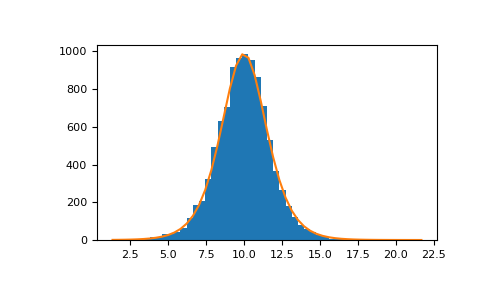numpy.random.Generator.logistic#
method
- random.Generator.logistic(loc=0.0, scale=1.0, size=None)#
Draw samples from a logistic distribution.
Samples are drawn from a logistic distribution with specified parameters, loc (location or mean, also median), and scale (>0).
- Parameters
- locfloat or array_like of floats, optional
Parameter of the distribution. Default is 0.
- scalefloat or array_like of floats, optional
Parameter of the distribution. Must be non-negative. Default is 1.
- sizeint or tuple of ints, optional
Output shape. If the given shape is, e.g.,
(m, n, k), thenm * n * ksamples are drawn. If size isNone(default), a single value is returned iflocandscaleare both scalars. Otherwise,np.broadcast(loc, scale).sizesamples are drawn.
- Returns
- outndarray or scalar
Drawn samples from the parameterized logistic distribution.
See also
scipy.stats.logisticprobability density function, distribution or cumulative density function, etc.
Notes
The probability density for the Logistic distribution is
\[P(x) = P(x) = \frac{e^{-(x-\mu)/s}}{s(1+e^{-(x-\mu)/s})^2},\]where \(\mu\) = location and \(s\) = scale.
The Logistic distribution is used in Extreme Value problems where it can act as a mixture of Gumbel distributions, in Epidemiology, and by the World Chess Federation (FIDE) where it is used in the Elo ranking system, assuming the performance of each player is a logistically distributed random variable.
References
- 1
Reiss, R.-D. and Thomas M. (2001), “Statistical Analysis of Extreme Values, from Insurance, Finance, Hydrology and Other Fields,” Birkhauser Verlag, Basel, pp 132-133.
- 2
Weisstein, Eric W. “Logistic Distribution.” From MathWorld–A Wolfram Web Resource. http://mathworld.wolfram.com/LogisticDistribution.html
- 3
Wikipedia, “Logistic-distribution”, https://en.wikipedia.org/wiki/Logistic_distribution
Examples
Draw samples from the distribution:
>>> loc, scale = 10, 1 >>> s = np.random.default_rng().logistic(loc, scale, 10000) >>> import matplotlib.pyplot as plt >>> count, bins, ignored = plt.hist(s, bins=50)
# plot against distribution
>>> def logist(x, loc, scale): ... return np.exp((loc-x)/scale)/(scale*(1+np.exp((loc-x)/scale))**2) >>> lgst_val = logist(bins, loc, scale) >>> plt.plot(bins, lgst_val * count.max() / lgst_val.max()) >>> plt.show()
